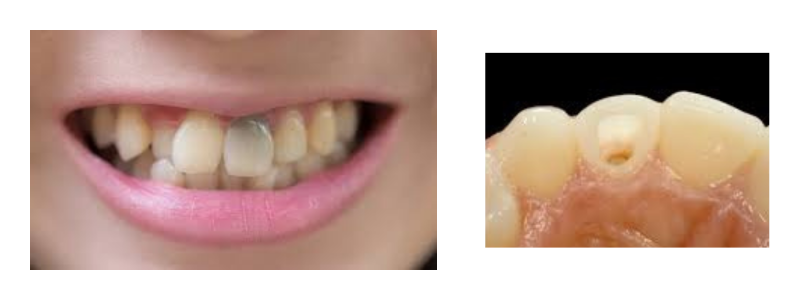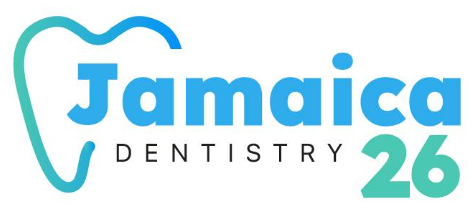Internal Bleaching

Internal Bleaching That Fixes Dark, Discolored Teeth Fast
A single dark or discolored tooth can affect the appearance of your entire smile. While most people are familiar with surface stains caused by coffee, tea, or tobacco, some discoloration comes, itself. This type of staining is also known as internal discoloration. It is usually the result of trauma, infection, and a past root canal treatment. Unlike external stains, internal stains don’t respond to over-the-counter whitening products or regular cleaning. They require specific treatment, designed to work from the inside out. Internal bleaching is a safe, fast, and highly effective method used to lighten non-vital teeth that have darkened over time.
This is a minimally invasive procedure where the results are natural and do not involve crowns or veneers.
At Jamaica 26 dentistry, we offer traditional modern internal bleaching products to regain that white glow of your smile in a quick, comfortable way that you can have faith in.
What Is Internal Bleaching?
Non-vital bleaching, usually called internal bleaching, is a cosmetic dental procedure that can be used to lighten a stained tooth. This tooth has often been darkened by the inside becoming discoloured, typically due to injury, infection or root canal approach. Internal bleaching as opposed to external forms of whitening occurs within the tooth and specifically attacks deep stains within the dentin since the internal process is completed within the tooth, the process is able to attack the stains more directly and precisely. This method is used to insert a harmless whitening substance into the alarm-concentrated pulp cavity to enable a tooth to gradually brighten by the inward process. It is typically suggested with regard to dead teeth (non-vital) where normal whitening would be ineffective.
Internal bleaching is less invasive compared to other cosmetic methods that may look more drastic such as crowns or veneers. It conserves your teeth structure, and is cosmetically dramatic. At Jamaica 26 Dentistry, we offer expert care and can easily treat dull grey teeth in an effective and comfortable way as we take advantage of all the latest modern methods of whitening (internal bleaching).
Causes of Internal Tooth Discoloration
- Internal tooth discoloration is a situation when the stain grows on the inside of the tooth and not on the surface. The staining is usually due to trauma, in that case, internal bleeding occurs due to an injury to the tooth. Blood breakdown products have over time been able to dull the tooth structure.
- The other typical cause is a treated root canal tooth. The tooth can also lose vigor and start to turn color after treatment because of remaining pulp tissue or internal hemorrhage. Necrosis of a pulp, the nerve tissue is killed in the tooth, and internal infection of the tooth may also cause a gray, brown, or yellowish hue.
- Normal whitening products strips, gels, whitening toothpaste do not combat internal stains. These are treatments that only penetrate the surface enamel and are unable to access deeper layers where the discoloration is present.
- This usually frustrates the patients or even makes them self-conscious when they only have a dark tooth amidst their smile.
How the Internal Bleaching Procedure Works
- Internal bleaching is an accurate, in-office treatment that is performed by a dentist or dental expert. Tooth removal commences with a close inspection and X-RAY to ascertain the shape of the tooth and absence of active infection or destruction.
- When the tooth has been cleared to work on it, the dentist makes a small hole in the rear part of the tooth opening the inside part. Any remaining restorative dental material that remains or debris is softly removed to accommodate the bleaching agent.
- Deep internal stains are targeted by placing inside the tooth a safe and professional-grade whitening agent. This is then covered with a temporary filling and the patient should be advised for a follow-up visit.
- It can be repeated once or twice until obtaining a preferred shade. After the tooth attains an appropriate brightness, the temporary filling is discarded and a permanent cement is applied.
- The majority of the patients obtain full results after 1 to 3 visits with the results varying according to the extent of stains. The internal bleaching done at Jamaica 26 Dentistry is safe and comfortable with a minimally invasive method with controlled procedures to safely bring back your teeth color they were naturally meant to be by initiating the process internally.
Benefits of Internal Bleaching
- The use of internal bleaching has several advantages for the patient experiencing dark or discolored teeth. First, it makes your teeth appear its natural color without touching the enamel and the other teeth. The process itself is minimally invasive with no need to shave or drill the external structure of the teeth.
- The majority of patients get fast results, usually in a matter of one to three visits, and little to no discomfort involved. The effects of good care when it is well taken care of can prove to be eternal and thus it becomes a good investment when your smile is concerned.
- Internal bleaching is cheaper than cosmetics such as veneers or crowns on teeth and it maintains your natural tooth color. The best part is that by fixing one dark tooth you can make your smile appear more beautiful, which can raise your self-confidence and enable you to feel more confident in social or business situations.
- It is a clear cut solution with huge results when carried out by a good provider such as Jamaica 26 Dentistry.
Risks and Considerations
Even though internal tooth bleaching is mostly safe, one should be aware of the possible risks. Minor sensitivity to teeth can be felt by some patients, particularly during the initial treatment. This sensitivity tends to be transient and for a short duration. Occasionally, retreatment at a later date might be necessary in the case of discoloration reoccurring. There is also a slight possibility of excess bleaching, particularly if it is done improperly. This is the reason why DIY whiteners cannot be used on internally stained teeth because they are not made to treat them and may cause complications.
It is necessary to choose a qualified specialist. Here at Jamaica 26 Dentistry, we incorporate the tried and tested methods of modalities and gentleness and go to great lengths to make sure that internal bleaching is not only safe but effective for every individual.
How Internal Bleaching Compares to Other Whitening Options
- When looking at the alternatives to internal bleaching, it is necessary to understand the major differences. Other external means of whitening, such as strips, gels, or professional cleanings, can only take away surface stains. Trauma and root canals do not cause these products to become very dark.
- A few patients resort to veneers or crowns to cover a dark tooth. These procedures may be acceptable, but they are complicated and costly with the possible necessity to destroy healthy tooth structure.
- On the other hand, internal bleaching is a cheaper and non-versatile technique, and it applies when whitening a non-vital tooth. It addresses the underlying cause of the discoloration of the deep stains under the dentin without interfering with adjacent teeth.
How to Maintain the Results After Internal Bleaching
Good oral hygiene will help you to keep your outcomes of internal bleaching. Use a brush and floss regularly to avoid plaque formation which will give your teeth a dull look. Try not to discolour foods or beverages such as coffee, tea, or red wine or use a straw when you savour them.
Smoking should be avoided as it may cause discoloration. Make dental appointments to have the tooth checked regularly and hence maintain its health.
Why Choose Jamaica 26 Dentistry for Internal Bleaching?
- We also provide special services in cosmetic and restorative dental treatment, such as modern internal bleaching procedures. We practice a patient-centered approach, along with the incredibly effective use of gentle practices, and use modern dental equipment to achieve excellent outcomes.
- We apply gentle, tried and tested materials to achieving the bleaching of internal stains without degrading your tooth structure. Every treatment is designed per individual’s requirements, which makes the process as hassle-free as possible.
- Our clinic is the place to provide a warm, supportive environment during consultation and aftercare appointments and is conveniently located to fit into busy lifestyles. Leave it to our professional staff to bring your teeth back to their former natural color and allow you the experience of smiling with aplomb safely, beautifully, and at low cost.
Conclusion
Internal bleaching is a cheaper method of restoring a single dark or discolored tooth that is a result of trauma or the result of a root canal procedure. It provides quick, safe and natural results with no crowns or veneers. And in case you are getting frustrated with not smiling freely due to a dark tooth, time to act. Jamaica 26 dentistry is a clinically advanced solution to internal bleaching that can deliver a brighter, more balanced or even smile with comfort and confidently. Request your consultation and make a start on a smile you will love to share.
Frequently Asked Questions
Is internal bleaching painful?
No, there is no pain with internal bleaching. Most patients feel no pain after or during the procedure because the tooth under treatment is non-vital (it does not have a live nerve). Some experience mild sensitivity, in some, this may occur especially when the whitening agent is put on, though it generally subsides within a short time. Your dentist will make you comfortable during the process.
How long does internal bleaching last?
Internal bleaching can give results lasting a few years with proper care. Nevertheless, there are chances that some teeth will become darker with time once more, particularly in case the tooth is extremely traumatized. In this scenario, the brightness can be easily achieved by touching up.
Will the bleached tooth match my other teeth?
Yes. Dentists are able to carefully regulate whitening color so that the result of the treatment looks like a part of your other natural teeth. The aim is to have an even smile with an even brightness. When treating a tooth, getting colors to match is one of the processes involved.
Can a previously bleached tooth discolor again?
Yes, mostly when the tooth is black or when some pulp tissue is still there. Due to age, it may discolor a bit over time. But repeated internal bleaching is safe when necessary. Your dentist will observe the tooth during regular dental visits and advise on retreatment only when it is vital.
Is internal bleaching safe for children or teens?
Internal bleaching is normally prescribed to adults whose teeth have already fully. It can also potentially be considered in extraordinary cases of teenagers after due assessment. It should be remembered that a tooth must be fully developed at the end of the root with no infection or structural damage.
Can I do internal bleaching at home?
No, internal bleaching is something that must be done by a qualified dental professional. The over-the-counter products are intended to be used for external whitening and fail to access the stains within the tooth. When you attempt to bleach a tooth at home you might end up damaging or infecting the tooth, or bleaching it ineffectively.
